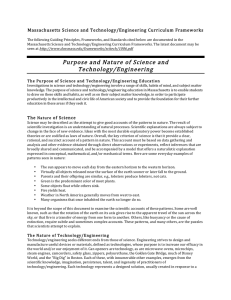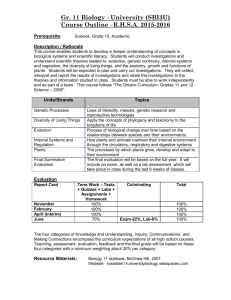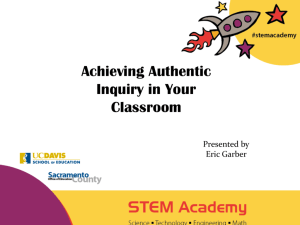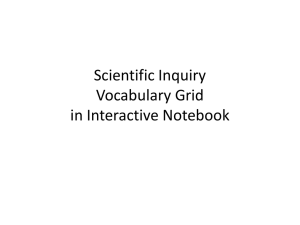Massachusetts Science and Technology/Engineering Curriculum Frameworks
advertisement
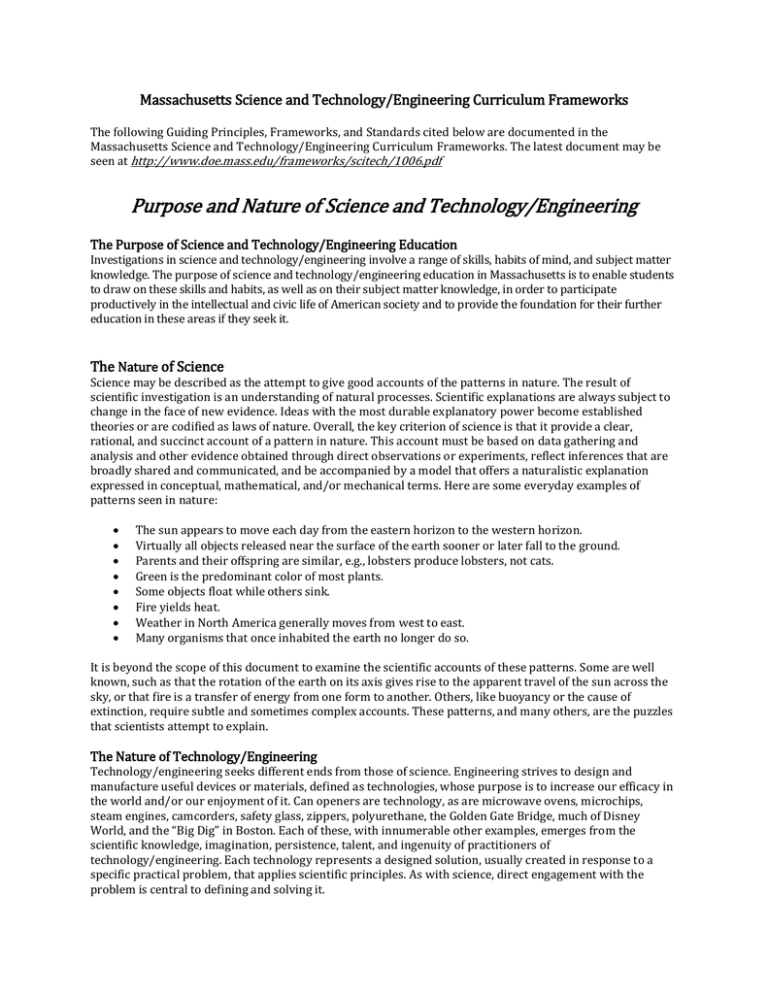
Massachusetts Science and Technology/Engineering Curriculum Frameworks The following Guiding Principles, Frameworks, and Standards cited below are documented in the Massachusetts Science and Technology/Engineering Curriculum Frameworks. The latest document may be seen at http://www.doe.mass.edu/frameworks/scitech/1006.pdf Purpose and Nature of Science and Technology/Engineering The Purpose of Science and Technology/Engineering Education Investigations in science and technology/engineering involve a range of skills, habits of mind, and subject matter knowledge. The purpose of science and technology/engineering education in Massachusetts is to enable students to draw on these skills and habits, as well as on their subject matter knowledge, in order to participate productively in the intellectual and civic life of American society and to provide the foundation for their further education in these areas if they seek it. The Nature of Science Science may be described as the attempt to give good accounts of the patterns in nature. The result of scientific investigation is an understanding of natural processes. Scientific explanations are always subject to change in the face of new evidence. Ideas with the most durable explanatory power become established theories or are codified as laws of nature. Overall, the key criterion of science is that it provide a clear, rational, and succinct account of a pattern in nature. This account must be based on data gathering and analysis and other evidence obtained through direct observations or experiments, reflect inferences that are broadly shared and communicated, and be accompanied by a model that offers a naturalistic explanation expressed in conceptual, mathematical, and/or mechanical terms. Here are some everyday examples of patterns seen in nature: The sun appears to move each day from the eastern horizon to the western horizon. Virtually all objects released near the surface of the earth sooner or later fall to the ground. Parents and their offspring are similar, e.g., lobsters produce lobsters, not cats. Green is the predominant color of most plants. Some objects float while others sink. Fire yields heat. Weather in North America generally moves from west to east. Many organisms that once inhabited the earth no longer do so. It is beyond the scope of this document to examine the scientific accounts of these patterns. Some are well known, such as that the rotation of the earth on its axis gives rise to the apparent travel of the sun across the sky, or that fire is a transfer of energy from one form to another. Others, like buoyancy or the cause of extinction, require subtle and sometimes complex accounts. These patterns, and many others, are the puzzles that scientists attempt to explain. The Nature of Technology/Engineering Technology/engineering seeks different ends from those of science. Engineering strives to design and manufacture useful devices or materials, defined as technologies, whose purpose is to increase our efficacy in the world and/or our enjoyment of it. Can openers are technology, as are microwave ovens, microchips, steam engines, camcorders, safety glass, zippers, polyurethane, the Golden Gate Bridge, much of Disney World, and the “Big Dig” in Boston. Each of these, with innumerable other examples, emerges from the scientific knowledge, imagination, persistence, talent, and ingenuity of practitioners of technology/engineering. Each technology represents a designed solution, usually created in response to a specific practical problem, that applies scientific principles. As with science, direct engagement with the problem is central to defining and solving it. The Relationship Between Science and Technology/Engineering In spite of their different goals, science and technology have become closely, even inextricably, related in many fields. The instruments that scientists use, such as the microscope, balance, and chronometer, result from the application of technology/engineering. Scientific ideas, such as the laws of motion, the relationship between electricity and magnetism, the atomic model, and the model of DNA, have contributed to achievements in technology and engineering, such as improvement of the internal combustion engine, power transformers, nuclear power, and human gene therapy. The boundaries between science and technology/engineering blur together to extend knowledge. Inquiry, Experimentation, and Design in the Classroom Inquiry-Based Instruction Engaging students in inquiry-based instruction is one way of developing conceptual understanding, content knowledge, and scientific skills. Scientific inquiry as a means to understand the natural and human-made worlds requires the application of content knowledge through the use of scientific skills. Students should have curricular opportunities to learn about and understand science and technology/engineering through participatory activities, particularly laboratory, fieldwork, and design challenges. Inquiry, experimentation, and design should not be taught or tested as separate, stand-alone skills. Rather, opportunities for inquiry, experimentation, and design should arise within a well-planned curriculum. Instruction and assessment should include examples drawn from life science, physical science, earth and space science, and technology/engineering standards. Doing so will make clear to students that what is known does not stand separate from how it is known. Asking Questions Asking questions and pursuing answers are keys to learning in all academic disciplines. In the science classroom, one way students can do this is by exploring scientific phenomena in a classroom laboratory or an investigation around the school. Investigation and experimentation build essential scientific skills such as observing, measuring, replicating experiments, manipulating equipment, and collecting and reporting data. Students may choose what phenomenon to study or conduct investigations and experiments that are selected and guided by the teacher. Students can also examine questions pursued by scientists in previous investigations of natural phenomena and processes, as reported or shown in textbooks, papers, videos, the Internet, and other media. These sources are valuable because they efficiently organize and highlight key concepts and supporting evidence that characterize the most important work in science. Such study can then be supported in the classroom by demonstrations, experiments, or simulations that deliberately manage features of a natural object or process. Whatever the instructional approach, science instruction should include both concrete and manipulable materials, along with explanatory diagrams and texts. Investigations An inquiry-based approach to science education also engages students in hands-on investigations that allow them to draw upon their prior knowledge and build new understandings and skills. Hands-on experiences should always be purposeful activities that are consistent with current research on how people learn and that develop student understanding of science concepts. Students should also have multiple opportunities to share, present, review, and critique scientific information or findings with others. The characteristics of investigations develop through the different grade spans: In high school, students develop greater independence in designing and carrying out experiments, most often working alone or in small groups. They come up with questions and hypotheses that build on what they have learned from secondary sources. They learn to critique and defend their findings, and to revise their explanations of phenomena as new findings emerge. Their facility with using a variety of physical and conceptual models increases. Students in the final two years of high school can be encouraged to carry out extended independent experiments that explore a scientific hypothesis in depth, sometimes with the assistance of a scientific mentor from outside the school setting. Preparation for post-secondary opportunities is another reason to provide regular laboratory and fieldwork experiences in high school science and technology/engineering courses. The Massachusetts Board of Higher Education’s Admissions Standards for the Massachusetts State Colleges and University (www.mass.edu\a_f) states that three science courses, including two courses with laboratory work, must be completed in order to fulfill the minimum science requirement for admission to the Commonwealth’s four-year public institutions. All high school courses based on the standards presented in this document should include substantial laboratory and/or fieldwork to allow all students the opportunity to meet or exceed this requirement of the Massachusetts Board of Higher Education. The Engineering Design Process Just as inquiry and experimentation guide investigations in science, the Engineering Design Process guides solutions to technology/engineering design challenges. Learning technology/engineering content and skills is greatly enhanced by a hands-on, active approach that allows students to engage in design challenges and safely work with materials to model and test solutions to a problem. Using the steps of the Engineering Design Process, students can solve technology/engineering problems and apply scientific concepts across a wide variety of topics to develop conceptual understanding. The specific steps of the Engineering Design Process are included in the Technology/Engineering strand, on page 84 of this Framework. Skills of Inquiry, Experimentation, and Design All students need to achieve a sufficient level of scientific literacy to enable them to succeed in post-secondary education, in careers, and as contributing members of a democratic society. To achieve this, students need to develop skills that allow them to search out, describe, and explain natural phenomena and designed artifacts. Scientific inquiry, experimentation, and design involve practice (skills) in direct relationship to knowledge; content knowledge and skills are necessary to inquire about the natural and human-made worlds. The skills for grades PreK–8 listed below are unchanged from those presented in the 2001 Framework. The new Scientific Inquiry Skills standards listed for high school reflect essential elements of scientific practice and should be integrated into curriculum along with content standards. High School This Framework introduces four Scientific Inquiry Skills (SIS) standards that are included in each introductory high school course (except Technology/Engineering, where they are replaced by the steps of the Engineering Design Process): SIS1. SIS2. SIS3. SIS4. Make observations, raise questions, and formulate hypotheses. Design and conduct scientific investigations. Analyze and interpret results of scientific investigations. Communicate and apply the results of scientific investigations. In each course, each Scientific Inquiry Skills standard includes an example skill set that further defines and articulates the standard. Also new to the 2006 Framework are the lists of mathematical skills needed for a solid understanding of each high school science and technology/engineering course. Engaging in science and technology/engineering often involves the use of mathematics to analyze and support findings of investigations or the design process. Most mathematical skills listed are based on grade-appropriate standards outlined in the Massachusetts Mathematics Curriculum Framework. Any specialized mathematical skills not detailed in the Mathematics Framework are listed separately. Please note that these lists are provided only as examples and are not exhaustive; the lists do not represent all mathematical skills students might need in a typical course. Guiding Principles The following Guiding Principles present a set of tenets about effective PreK–12 science and technology/engineering programs. The goal of the Guiding Principles is to help educators create inquirybased educational environments that encourage student curiosity, engagement, persistence, respect for evidence, and sense of responsibility. GU IDING PRINC IPLE I A comprehensive science and technology/engineering education program enrolls all students from PreK through grade 12. Students benefit from studying science and technology/engineering throughout all their years of schooling. They should learn the fundamental concepts of each domain of science, as well as the connections across those domains and to technology/engineering. This Framework will assist educators in developing science and technology/engineering programs that engage all students. All students in grades PreK–5 should have science instruction on a regular basis every year. Approximately one-quarter of PreK–5 science time should be devoted to technology/ engineering. In grades 6–8, students should have a full year of science study every year. Students in grades 6–8 should have one year of technology/engineering education in addition to their three years of science. Schools may choose to offer technology/engineering as a semester course in each of two years; as a full-year course in grade 8; or in three units, one each year in grades 6, 7, and 8. In grades 9 and 10, all students should have full-year laboratory-based science and technology/engineering courses. In grades 11 and 12, students should take additional science and technology/engineering courses or pursue advanced study through advanced placement courses, independent research, or study of special topics. GU IDING PRINC IPLE II An effective science and technology/engineering program builds students’ understanding of the fundamental concepts of each domain of science, and their understanding of the connections across these domains and to basic concepts in technology/engineering. Each domain of science has its particular approach and area of focus. However, students need to understand that much of the scientific work done in the world draws on multiple disciplines. Oceanographers, for instance, use their knowledge of physics, chemistry, biology, earth science, and technology to chart the course of ocean currents. Connecting the domains of natural science with mathematical study and with one another, and to practical applications through technology and engineering, should be one goal of science education. In the elementary grades, coursework should integrate all of the major domains of science and technology/engineering every year. In one approach, instruction can be organized around distinct but complementary units drawn from the earth, life, and physical sciences and from technology/engineering. In another approach, teachers working together and with outside help (e.g., museum personnel, scientists, or engineers) can organize activities around concepts or topics unifying all of the domains. At the middle and high school levels, science faculty may choose either a discipline-based or an integrated approach in science. In choosing an approach, faculty will want to consider the particular content expertise of teachers and the academic goals, abilities, and interests of students. In this document, the high school standards are written to allow for choice in course organization and sequence. GU IDING PRINC IPLE III Science and technology/engineering are integrally related to mathematics. Mathematics is an essential tool for scientists and engineers because it specifies in precise and abstract (general) terms many attributes of natural phenomena and manmade objects and the nature of relationships among them. Mathematics facilitates precise analysis and prediction. Take, for example, the equation for one of Newton’s Laws: F = ma (force equals mass times acceleration). This remarkably succinct description states the invariable relationship among three fundamental features of our known universe. Its mathematical form permits all kinds of analyses and predictions. Other insights come from simple geometric analysis applied to the living world. For example, volume increases by the cube of an object’s fundamental dimension while area increases by the square. Thus, in an effort to maintain constant body temperature, most small mammals metabolize at much higher rates than larger ones. It is hard to imagine a more compelling and simple explanation than this for the relatively high heart rate of rodents versus antelopes. Even simpler is the quantification of dimensions. How small is a bacterium, how large is a star, how dense is lead, how fast is sound, how hard is a diamond, how sturdy is the bridge, how safe is the plane? These questions can all be answered mathematically. And with these analyses, all kinds of intellectual and practical questions can be posed and solved. Teachers, curriculum coordinators, and others who help implement this Framework must be aware of the level of mathematical knowledge needed for each science and technology/ engineering course, especially at the high school level, and must ensure that the appropriate mathematical knowledge has already been taught or is being taught concurrently. GU IDING PRINC IPLE IV An effective program in science and technology/engineering addresses students’ prior knowledge and misconceptions. Students are innately curious about the world and wonder how things work. They may make spontaneous, perceptive observations about natural objects and processes, and can often be found taking things apart and reassembling them. In many cases, they have developed mental models about how the world works. However, these mental models may be inaccurate, even though they make sense to the students, and inaccuracies work against learning. Research into misconceptions demonstrates that children can hold onto misconceptions even while reproducing what they have been taught are the “correct answers.” For example, young children may repeat that the earth is round, as they have been told, while continuing to believe that the earth is flat, which is what they can see for themselves. They may find a variety of ingenious ways to reconcile their misconception with the correct knowledge, e.g., by concluding that we live on a flat plate inside the round globe. Teachers must be skilled at uncovering inaccuracies in students’ prior knowledge and observations, and in devising experiences that will challenge inaccurate beliefs and redirect student learning along more productive routes. The students’ natural curiosity provides one entry point for learning experiences designed to remove students’ misconceptions in science and technology/engineering. GU IDING PRINC IPLE V Investigation, experimentation, and problem solving are central to science and technology/engineering education. Investigations introduce students to the nature of original research, increase students’ understanding of scientific and technological concepts, promote skill development, and provide entry points for all learners. Teachers should establish the learning goals and contexts for investigations, experiments, and laboratories; guide student activities; and help students focus on important ideas and concepts. Lessons should be designed so that knowledge and skills are developed and used together (also see Inquiry, Experimentation, and Design in the Classroom, pages 9–12). Puzzlement and uncertainty are common features in experimentation. Students need time to examine their ideas as they apply them in explaining a natural phenomenon or solving a design problem. Opportunities for students to reflect on their own ideas, collect evidence, make inferences and predictions, and discuss their findings are all crucial to growth in understanding. Students should also have opportunities in the classroom to replicate important experiments that have led to well-confirmed knowledge about the natural world, e.g., Archimedes’ principle and the electric light bulb. By examining the thinking of experts, students can learn to improve their own problem-solving efforts. GU IDING PRINC IPLE VI An effective science and technology/engineering program builds upon and develops students’ literacy skills and knowledge. Reading, writing, and communication skills are necessary elements of learning and engaging in science and technology/engineering. Teachers should consistently support students in acquiring comprehension skills and strategies, as well as vocabulary, to deepen students’ understanding of text meaning. Science and technology/engineering texts contain specialized knowledge that is organized in a specific way. For example, scientific texts will often articulate a general principle that describes a pattern in nature, followed by evidence that supports and illustrates the principle. Science and technology/engineering classrooms make use of a variety of text materials, including textbooks, journals, lab instructions, and reports. Texts are generally informational in nature, rather than narrative, and often include high proportions of facts and terms related to a particular phenomenon, process, or structure. Teachers should help students understand that the types of texts students read, along with the purpose(s) for reading these texts, are specific to science and technology/engineering. Supporting the development of students’ literacy skills will help them to deepen their understanding of science and technology/engineering concepts. Students should be able to use reading, writing, and communication skills to enhance their understanding of scientific and technological/engineering text materials, including informational text, diagrams, charts, graphs, and formulas; communicate ideas; and apply logic and reasoning in scientific and technological/engineering contexts. Students should be able to use a variety of texts to distinguish fact from opinion, make inferences, draw conclusions, and collect evidence to test hypotheses and build arguments. Successful development of these skills requires explicit opportunities to develop literacy skills and knowledge. GU IDING PRINC IPLE VII Students learn best in an environment that conveys high academic expectations for all students. A high quality education system simultaneously serves the goals of equity and excellence. At every level of the education system, teachers should act on the belief that young people from every background can learn rigorous science content and solve tough engineering problems. Teachers and guidance personnel should advise students and parents that rigorous courses and advanced sequences in science and technology/engineering will prepare them for success in college and the workplace. After-school, weekend, and summer enrichment programs offered by school districts or communities may be especially valuable and should be open to all. Schools and districts should also invite role models from business and the community (including professional engineers and scientists) to visit classes, work with students, and contribute to instruction. Regardless of whether students go on to an institute of higher education or to a workplace, they should be equipped with the skills and habits required for postsecondary success. Skills such as the ability to work through difficult problems, to be creative in problem solving, and to think critically and analytically will serve students in any setting. When students work toward high expectations in these areas, they develop the foundation they need for success after graduation. GU IDING PRINC IPLE VIII Assessment in science and technology/engineering serves to inform student learning, guide instruction, and evaluate student progress. Assessment reflects classroom expectations and shows outcomes of student learning based on established knowledge and performance goals. The learning standards in this Framework are a key resource for setting such knowledge and performance objectives in science and technology/engineering. Assessment assists teachers in improving classroom practice, planning curricula, developing self-directed learners, reporting student progress, and evaluating programs. It provides students with information about how their knowledge and skills are developing and what can be done to improve them. It lets parents know how well their children are doing and what needs to be done to help them do better. Using assessment data, teachers can better meet the needs of individual students as those students work toward mastery of the Framework learning standards. Teachers should assess student progress toward desired outcomes on a regular basis through formative assessments. Formative assessments allow a teacher to benchmark progress, evaluate the pace of instruction, and determine the need for intervention support. Through formative assessments, students receive timely feedback regarding their accomplishments and needs. Diagnostic information gained from multiple forms of assessment enables teachers to adjust their day-to-day and week-to-week practices to foster greater student achievement. The many types of assessment include paper-and-pencil testing, performance testing, interviews, and portfolios, as well as less formal inventories such as regular observation of student responses to instruction. In helping students achieve standards, assessments should also use a variety of question formats: multiple-choice, short-answer, and open-ended. Performance-based assessments should also be developed that allow students to demonstrate what they have learned in the context of solving a problem or applying a concept. This kind of assessment requires students to refine a problem, devise a strategy to solve it, apply relevant knowledge, conduct sustained work, and deal with both complex concepts and discrete facts. GU IDING PRINC IPLE IX An effective program in science and technology/engineering gives students opportunities to collaborate in scientific and technological endeavors and communicate their ideas. Scientists and engineers work as members of their professional communities. Ideas are tested, modified, extended, and reevaluated by those professional communities over time. Thus, the ability to convey their ideas to others is essential for these advances to occur. In order to learn how to effectively communicate scientific and technological ideas, students require practice in making written and oral presentations, fielding questions, responding to critiques, and developing replies. Students need opportunities to talk about their work in focused discussions with peers and with those who have more experience and expertise. This communication can occur informally, in the context of an ongoing student collaboration or on-line consultation with a scientist or engineer, or more formally, when a student presents findings from an individual or group investigation. Earth and Space Science In earth and space science, students study the origin, structure, and physical phenomena of the earth and the universe. Earth and space science studies include concepts in geology, meteorology, oceanography, and astronomy. These studies integrate previously or simultaneously gained understandings in physical and life science with the physical environment. Through the study of earth and space, students learn about the nature and interactions of oceans and the atmosphere, and of earth processes, including plate tectonics, changes in topography over time, and the place of the earth in the universe. At the high school level, students review geological, meteorological, oceanographic, and astronomical data to learn about Earth’s matter, energy, processes, and cycles. Through these data they also learn about the origin and evolution of the universe. Students gain knowledge about Earth’s internal and external energy sources, local weather and climate, and the dynamics of ocean currents. Students learn about the renewable and non-renewable energy resources of Earth and what impact these have on the environment. Through learning about Earth’s processes and cycles, students gain a better understanding of nitrogen and carbon cycles, the rock cycle, and plate tectonics. Students also learn about the origin of the universe and how scientists are currently studying deep space and the solar system. High school learning standards fall under the following four subtopics: Matter and Energy in the Earth System; Energy Resources in the Earth System; Earth Processes and Cycles; and The Origin and Evolution of the Universe. Earth and Space Science learning standards are also grouped under Broad Topics in Appendix I, which highlights the relationships of standards among grade spans. Earth and Space Science, High School Learning Standards for a Full First-Year Course I. CONTENT STANDARDS 1. Matter and Energy in the Earth System Central Concepts: The entire Earth system and its various cycles are driven by energy. Earth has both internal and external sources of energy. Two fundamental energy concepts included in the Earth system are gravity and electromagnetism. 1.1 Identify Earth’s principal sources of internal and external energy, such as radioactive decay, gravity, and solar energy. 1.2 Describe the characteristics of electromagnetic radiation and give examples of its impact on life and Earth’s systems. 1.3 Explain how the transfer of energy through radiation, conduction, and convection contributes to global atmospheric processes, such as storms, winds, and currents. 1.4 Provide examples of how the unequal heating of Earth and the Coriolis effect influence global circulation patterns, and show how they impact Massachusetts weather and climate (e.g., global winds, convection cells, land/sea breezes, mountain/valley breezes). 1.5 Explain how the revolution of Earth around the Sun and the inclination of Earth on its axis cause Earth’s seasonal variations (equinoxes and solstices). 1.6 Describe the various conditions associated with frontal boundaries and cyclonic storms (e.g., thunderstorms, winter storms [nor’easters], hurricanes, tornadoes) and their impact on human affairs, including storm preparations. Earth and Space Science, High School Learning Standards for a Full First-Year Course 1.7 Explain the dynamics of oceanic currents, including upwelling, deep-water currents, the Labrador Current and the Gulf Stream, and their relationship to global circulation within the marine environment and climate. 1.8 Read, interpret, and analyze a combination of ground-based observations, satellite data, and computer models to demonstrate Earth systems and their interconnections. 2. Energy Resources in the Earth System Central Concepts: Energy resources are used to sustain human civilization. The amount and accessibility of these resources influence their use and their impact on the environment. 2.1 Recognize, describe, and compare renewable energy resources (e.g., solar, wind, water, biomass) and nonrenewable energy resources (e.g., fossil fuels, nuclear energy). 2.2 Describe the effects on the environment and on the carbon cycle of using both renewable and nonrenewable sources of energy. 3. Earth Processes and Cycles Central Concepts: Earth is a dynamic interconnected system. The evolution of Earth has been driven by interactions between the lithosphere, hydrosphere, atmosphere, and biosphere. Over geologic time, the internal motions of Earth have continuously altered the topography and geography of the continents and ocean basins by both constructive and destructive processes. 3.2 Describe the carbon cycle. Physical Sciences (Chemistry and Physics) The physical sciences (chemistry and physics) examine the physical world around us. Using the methods of the physical sciences, students learn about the composition, structure, properties, and reactions of matter, and the relationships between matter and energy. Students are best able to build understanding of the physical sciences through hands-on exploration of the physical world. This Framework encourages repeated and increasingly sophisticated experiences that help students understand properties of matter, chemical reactions, forces and motion, and energy. The links between these concrete experiences and more abstract knowledge and representations are forged gradually. Over the course of their schooling, students develop more inclusive and generalizable explanations about physical and chemical interactions. Tools play a key role in the study of the physical world, helping students to detect physical phenomena that are beyond the range of their senses. By using well-designed instruments and computer-based technologies, students can better explore physical phenomena in ways that support greater conceptual understanding. In high school Introductory Physics, students recognize the nature and scope of physics, including its relationship to the other sciences. Students learn about basic topics such as motion, forces, energy, heat, waves, electricity, and magnetism. They learn about natural phenomena by using physical laws to calculate quantities such as velocity, acceleration, momentum, and energy. Students of introductory physics learn about the relationships between motion and forces through Newton’s laws of motion. They study the difference between vector and scalar quantities and learn how to solve basic problems involving these quantities. Students learn about conservation of energy and momentum and how these are applied to everyday situations. They learn about heat and how thermal energy is transferred throughout the different phases of matter. Students extend their knowledge of waves and how they carry energy. Students gain a better understanding of electric current, voltage, and resistance by learning about Ohm’s law. They also gain knowledge about the electromagnetic spectrum in terms of wavelength and frequency. Learning standards for high school Introductory Physics fall under the following six subtopics: Motion and Forces; Conservation of Energy and Momentum; Heat and Heat Transfer; Waves; Electromagnetism; and Electromagnetic Radiation. Physical Science learning standards are also grouped under Broad Topics in Appendix I, which highlights the relationships of standards among grade spans. Introductory Physics, High School Learning Standards for a Full First-Year Course I. CONTENT STANDARDS 1. Motion and Forces Central Concept: Newton’s laws of motion and gravitation describe and predict the motion of most objects. 1.7 Describe Newton’s law of universal gravitation in terms of the attraction between two objects, their masses, and the distance between them. 3. Heat and Heat Transfer Central Concept: Heat is energy that is transferred by the processes of convection, conduction, and radiation between objects or regions that are at different temperatures. 3.1 Explain how heat energy is transferred by convection, conduction, and radiation. 6. Electromagnetic Radiation Central Concept: Oscillating electric or magnetic fields can generate electromagnetic waves over a wide spectrum. 6.1 Recognize that electromagnetic waves are transverse waves and travel at the speed of light through a vacuum. 6.2 Describe the electromagnetic spectrum in terms of frequency and wavelength, and identify the locations of radio waves, microwaves, infrared radiation, visible light (red, orange, yellow, green, blue, indigo, and violet), ultraviolet rays, x-rays, and gamma rays on the spectrum. II. SCIENT IFIC INQUIRY SKILLS STANDARDS Scientific literacy can be achieved as students inquire about the physical world. The curriculum should include substantial hands-on laboratory and field experiences, as appropriate, for students to develop and use scientific skills in introductory physics, along with the inquiry skills listed below. SIS1. Make observations, raise questions, and formulate hypotheses. Observe the world from a scientific perspective. Pose questions and form hypotheses based on personal observations, scientific articles, experiments, and knowledge. Read, interpret, and examine the credibility and validity of scientific claims in different sources of information, such as scientific articles, advertisements, or media stories. SIS2. Design and conduct scientific investigations. Articulate and explain the major concepts being investigated and the purpose of an investigation. Select required materials, equipment, and conditions for conducting an experiment. Identify independent and dependent variables. Write procedures that are clear and replicable. Employ appropriate methods for accurately and consistently o making observations o making and recording measurements at appropriate levels of precision o collecting data or evidence in an organized way Properly use instruments, equipment, and materials (e.g., scales, probeware, meter sticks, microscopes, computers) including set-up, calibration (if required), technique, maintenance, and storage. Follow safety guidelines. Introductory Physics, High School Learning Standards for a Full First-Year Course SIS3. Analyze and interpret results of scientific investigations. Present relationships between and among variables in appropriate forms. o Represent data and relationships between and among variables in charts and graphs. o Use appropriate technology (e.g., graphing software) and other tools. Use mathematical operations to analyze and interpret data results. Assess the reliability of data and identify reasons for inconsistent results, such as sources of error or uncontrolled conditions. Use results of an experiment to develop a conclusion to an investigation that addresses the initial questions and supports or refutes the stated hypothesis. State questions raised by an experiment that may require further investigation. SIS4. Communicate and apply the results of scientific investigations. Develop descriptions of and explanations for scientific concepts that were a focus of one or more investigations. Review information, explain statistical analysis, and summarize data collected and analyzed as the result of an investigation. Explain diagrams and charts that represent relationships of variables. Construct a reasoned argument and respond appropriately to critical comments and questions. Use language and vocabulary appropriately, speak clearly and logically, and use appropriate technology (e.g., presentation software) and other tools to present findings. Use and refine scientific models that simulate physical processes or phenomena. III. MATHEMATICAL SKILLS Students are expected to know the content of the Massachusetts Mathematics Curriculum Framework, through grade 8. Below are some specific skills from the Mathematics Framework that students in this course should have the opportunity to apply: Construct and use tables and graphs to interpret data sets. Solve simple algebraic expressions. Perform basic statistical procedures to analyze the center and spread of data. Measure with accuracy and precision (e.g., length, volume, mass, temperature, time) Convert within a unit (e.g., centimeters to meters). Use common prefixes such as milli-, centi-, and kilo-. Use scientific notation, where appropriate. Use ratio and proportion to solve problems. The following skills are not detailed in the Mathematics Framework, but are necessary for a solid understanding in this course: Determine the correct number of significant figures. Determine percent error from experimental and accepted values. Use appropriate metric/standard international (SI) units of measurement for mass (kg); length (m); time (s); force (N); speed (m/s); acceleration (m/s2); frequency (Hz); work and energy (J); power (W); momentum (kgm/s); electric current (A); electric potential difference/voltage (V); and electric resistance (Ω). Use the Celsius and Kelvin scales.

